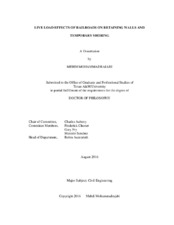| dc.description.abstract | Analysis of the causes of major train derailment and its effect on accident rates shows that the second most common reason for train derailment is changes in track geometry. Excavation near railroads is a significant potential cause of changes in the track geometry. Soldier pile walls and sheet pile walls are widely used as temporary shoring systems to minimize the vertical track settlement associated with nearby excavations. Design methods for these temporary shoring systems are typically based on (1) simple limit equilibrium calculations for dead loads from the soil self-weight and (2) elastic solutions for idealized geometries for predicting the effects of live loads. Both approaches involve significant simplifications, so conservative approaches are usually adopted to offset uncertainties in the analysis methodology.
The work in this dissertation focuses on the effects of live loads on temporary shoring systems. The results of this study indicate that while existing methodology is often conservative, it can be un-conservative under certain soil and site conditions. On the one hand, excessive conservatism can lead to needless costs. On the other hand, situations can arise where simplified methods are un-conservative. All of this points to the need for improved understanding of the mechanics of the response of temporary shoring systems to live loads in specific conditions.
The existing analysis methods, when tempered by engineering judgment, usually lead to safe designs. Thus, the intent of the completed research is not to supplant existing analysis methods with complex numerical models. Rather, the goal is to improve understanding of shored wall system behavior to provide guidelines on (1) when existing simplified analysis methods are appropriate and (2) when the simplified methods are potentially unsafe and more rigorous analyses should be undertaken. Generally, based on the finite element results it could be concluded that Boussinesq theory predicts more deflection for stiff soil and less deflection for soft soil. It means for stiff soil, the Boussinesq theory is conservative and for soft soil, it underestimates the deflection. | en |


